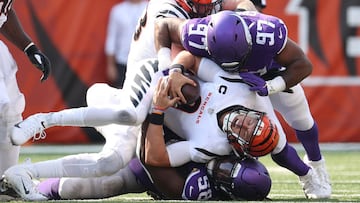What do NFL players wear around their neck? Does the Q-collar really work?
Can we trust the $200 online Q-Collar if million-dollar hydraulic helmets built in Stanford laboratories can’t eliminate brain damage.


Q-Collar promotes its device to hockey players, lacrosse players, bikers, surfers, kayakers, bull riders, and soldiers. Still, its best use case is American football, which has an existential concussion crisis.
Since Dr. Bennet Omalu discovered chronic traumatic encephalopathy in the brain of former Pittsburgh Steeler Mike Webster, the NFL has paid out hundreds of millions of dollars in settlements to thousands of families. The community has dealt with multiple brain damage-related suicides of prominent players, and its active players continue to wobble off the field after agonizing hits. As a result, some fans have stopped watching the game, while others feel uncomfortable when commentators praise a fallen player for “not seeming to be paralyzed.”
Last week, allegations surfaced that the widow of Matthew Gee, a former USC linebacker who died in 2018 after multiple head injuries, maybe the first to take the NCAA to court. Five 1989 Trojans linebackers died before 50, including Gee.
The game day essentials?
— Q-Collar (@QCollarOfficial) January 17, 2023
✅Cleats
✅Gloves
✅Stick
✅Elbow Pads
✅Helmet
✅Q-Collar
Make the Q-Collar an essential piece of your game day equipment.#QCollar #PlaySmartPlaySafe #CollarUp pic.twitter.com/xm8hoVEwE4
It’s soothing to imagine a magic technology might fix this problem.
Now we may enjoy large guys hitting other big men again without worrying about their brains 15 years from now. The Q-Collar has become increasingly popular in college and professional football this season. Carolina Panthers linebacker Luke Kuechly was the first high-profile player to wear it.
However, medical professionals have criticized the Q-mechanics Collars and the conflicts of interest in almost every paper claiming its effectiveness (Dr. David Smith, the Q-original Collar’s patent holder, is a frequent co-author).
When hit, the brain sloshes within the skull. Contact sports and concussions know this. As blows accumulate, CTE develops. The Q-Collar applies “light pressure to the sides of the neck” and “increases blood volume in the brain’s venous structures” to cushion the brain. Less slop, less damage. With no impact on comfort or performance, a jugular compression collar might keep a tablespoon of blood up there, making the game safer.
The science is not all there for the Q-Collar
Science’s unclear. Physiologist Dr. James Smoliga authored an essay for ‘The Conversation’ in 2018 and provided a lengthy Twitter thread with scientific sources for every tweet. Summary? Q-two Collar’s main scientific inspirations—concussion occurrence at altitude and the woodpecker’s anatomy—are risky for a device supposed to eliminate brain injuries from America’s most deadly sport.
Related stories
Q-Collar experts have often cited studies showing a lower incidence of concussions in games at higher altitudes (like Denver’s Mile High Stadium) because the brain “swells” with more blood and protection. They believed a Q-Collar might capture that swell shield for sea-level games. The brain swells, but not enough to matter. Q-Collar chose a season and data set for its offering.
Can we trust the $200 online Q-Collar if million-dollar hydraulic helmets built in Stanford laboratories can’t eliminate brain damage risk in America’s high-contact sports? Last year, the FDA authorized the device with the warning, “[The Q-Collar] hasn’t been shown to prevent concussions or severe brain injury.” Though its makers claim it may reduce micro-injuries (also known as “repetitive sub-concussive head blows”), sportsmen would be foolish not to wear it.

